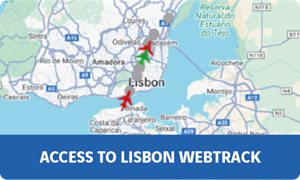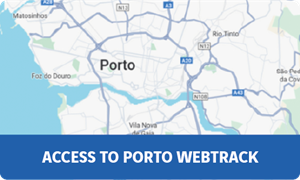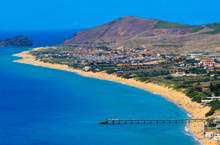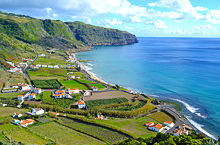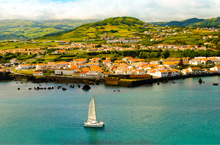Environment & Sustainability
- Environment at ANA
- Our airports
- Our commitments
- Our environmental management
- Life Moonset project
- WebTrak
- Portugal's Biosphere Reserves
Noise
Gestão da água
A continuously operating Noise Monitoring System was implemented at ANA airports with the aim of monitoring and controlling noise levels, focusing particularly on the noise generated by aircraft. This system is in operation at Humberto Delgado Airport (Lisboa), Francisco Sá Carneiro Airport (Porto), Gago Coutinho Airport (Faro) and Madeira Airport.
Noise is part of a priority strategic area under the scope of ANA’s environmental management. The plans to minimise the impact of airport infrastructure noise take different forms, requiring a holistic approach covering the source, reception areas and transmission paths. An optimal solution requires the combination of as many alternatives as possible in order to effectively minimise the effects of noise on the neighbouring community, ensuring affordable costs through the rational use of resources, in accordance with the “balanced approach” principle widely recommended by the EU.
Bearing in mind the principle of continuous improvement, the minimisation of negative impacts is a permanent challenge, and control and monitoring are crucial tools for the pursuit of this objective.
Humberto Delgado Airport has six fixed monitoring stations and two stations on the airport perimeter for checking use of the engine braking procedure. Francisco Sá Carneiro Airport, Gago Coutinho Airport and Madeira Airport are equipped with three fixed stations each. The monitoring is complemented by one portable station at each airport in order to enable analyses to be carried out in places not covered by the fixed stations, or in response to any complaints made. A portable station is used for continuous monitoring at Porto Santo Airport
In the specific case of João Paulo II Airport, the Noise Monitoring Reports are prepared by an external laboratory, based on monitoring campaigns carried out per IATA period.
Simulations/forecasts are also carried out through the regular preparation of Noise Maps which characterise the acoustic environment around larger airports, where more significant impacts regarding aircraft-specific noise are more likely to occur.
To this end, Noise Maps are drawn up for Humberto Delgado Airport, Sá Carneiro Airport, Gago Coutinho Airport and Madeira Airport. They are also prepared for Porto Santo Airport, as these are integral parts of the airport’s noise monitoring reports for that airport. Real data associated with aircraft movements during the reference periods are used, thus ensuring higher accuracy in the results obtained. These are preceded by validation using the results from the continuous noise monitoring stations installed in and around the airport.

Information on aircraft movements
ANA, through the WebTrak tool, provides operational and acoustic information associated with aircraft movement of Humberto Delgado Airport (Lisbon) and Francisco Sá Carneiro Airport (Porto), in a reliable and transparent way.
For security reasons, information relating to military activity is not disclosed, as the application is exclusively for civil aviation. Also, for the same reason, the information is displayed with 30 minutes delay, compared to the current operation. One month of historical data is available.
This application processes radar data from NAV - Navegação Aérea de Portugal, EPE, allowing the identification of each type of operation - landing, take-off, overflight - with the trajectories represented according to a color code - red, green, gray - respectively. It provides information such as: flight number, aircraft type, altitude, and flight origin.
The acoustic information is based on data from the Noise Monitoring Stations (NMS) of ANA - Aeroportos de Portugal, strategically installed in the airport surroundings, and accreditation issues of the acoustic tests are guaranteed in light of the legislation in force. The noise levels shown correspond to the instantaneous records of the NMS, resulting from all noise sources, that is, the ambient noise. This consists, therefore, in the sum of particular noise (associated with aircraft passage, if any) and residual noise (associated with other noise sources, for example, road traffic, urban areas, etc.). The instantaneous noise is not comparable with legal limits in force, as the latter refer to average values (in a representative period), calculated as defined in General Noise Regulation.
If you have difficulty accessing WebTrak, please contact: WebTrak@envirosuite.com
If you have any questions on WebTrak usage, please contact our Environment and Sustainability area: geral.ambiente@ana.pt
-
1. Noise, what is it?
Noise is an audible manifestation of mechanical vibrations in a physical, elastic medium, like air. The vibrations heard by the human ear are a sound signal with different physical parameters, the main ones being the intensity and frequency of the sound.
-
2. How is noise measured?
Sound levels are measured in decibels (dB), on a logarithmic scale, where 0 dB is considered to be the "threshold of hearing" (the minimum noise a human being is capable of hearing) and 120 dB is the "threshold of pain" (the level from which the human ear begins to suffer physical damage.)
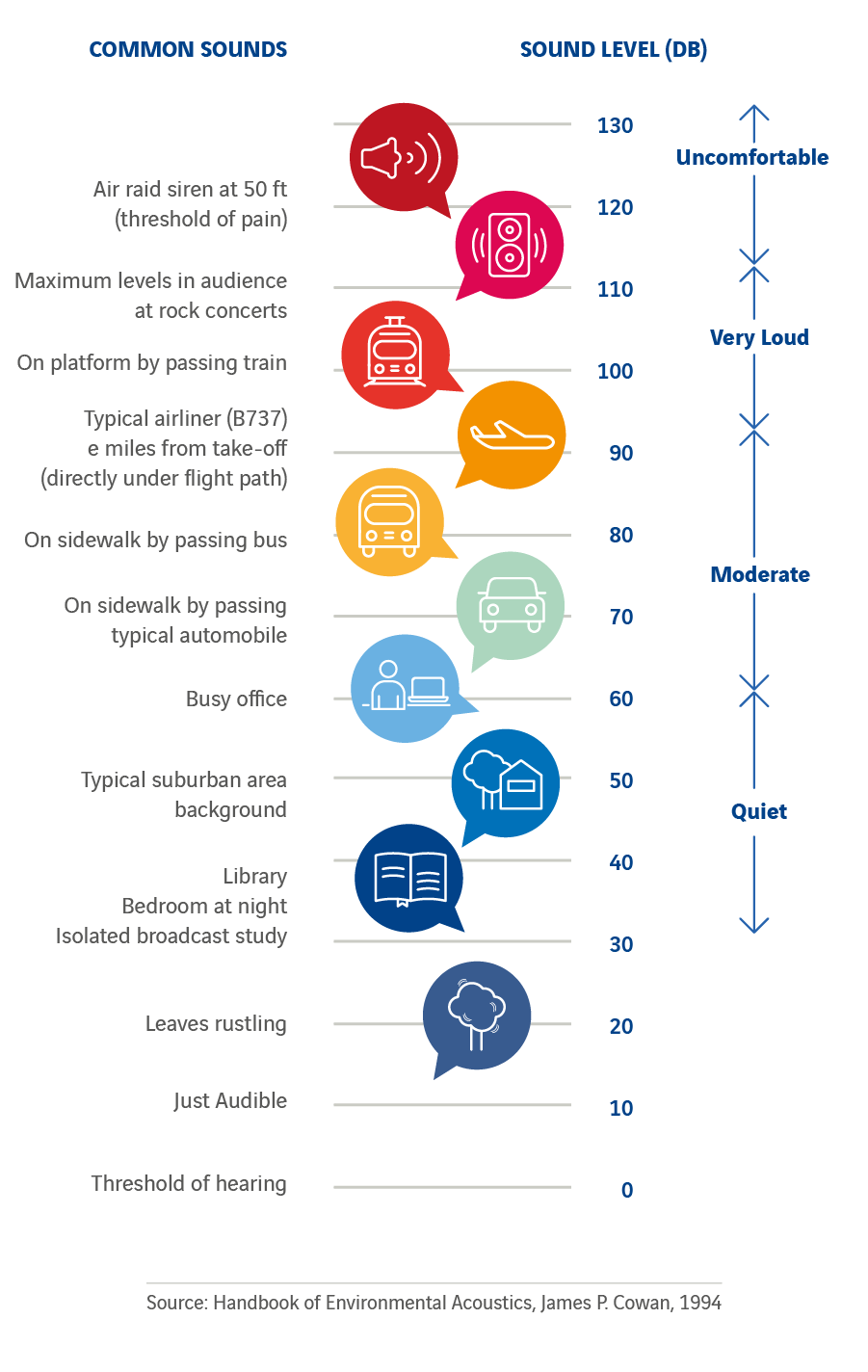
-
3. What is a decibel?
The decibel, dB(A) or dBA, is the level of sound pressure (intensity) at which human beings can actually hear a certain noise.
-
4. What equipment do we use to measure noise levels?
All ANA airports have noise monitoring systems, consisting of monitoring stations (microphone, sound level meters and weather stations), distributed along the runway approach areas.
The measurement of noise levels follows strict procedures, and the acoustic testing is accredited according to the legal regulations in force.
Through this system, it is possible to distinguish total environmental noise (sum of all sound sources) from a particular noise (in this case, associated with aircraft), and residual noise (environmental noise minus the particular noise).

-
5. Can I accurately measure noise levels using mobile phone apps?
No. No mobile phone is properly calibrated for this, so the results will almost always be inaccurate. In addition, there are specific measuring procedures which are in accordance with legal (and physical) requirements to ensure their accuracy. It should be added that it is also essential to be able to distinguish particular noise in order to be able to effectively measure its contribution in relation to total environmental noise (sum of all noise sources). Otherwise, we would simply be measuring the sum of all noise sources without understanding the specific contribution of the planes.
In the same way, when using mobile phone apps, the noise that is normally measured is what is called instantaneous noise, where, in terms of the applicable legal requirements, what is used is an integration of specific noise indicators for a certain time. Therefore, comparison exercises are not possible
-
6. How are legal noise limits defined?
According to the General Noise Regulation, legal noise limits are established for two different indicators – the entire day and the night-time period.
In either case, they refer to total environmental noise (sum of all sound sources). Therefore, the maximum noise limits set by law do not directly correspond to a level of particular noise, such as from an aircraft, but rather a set of different noises in the city.
-
7. What causes aircraft noise?
Aircraft noise is produced in ground and air operations and comes from two main sources - the airframe and the engine.
The noise from the airframe is caused by the passage of air over the plane's airframe. The amount of noise depends on the type of aircraft, the speed it is travelling at and its flight configuration. For example, when approaching the runway, the aircraft produces more air resistance caused by drag when the landing gear is lowered, creating more noise than if the landing gear was up and housed in the fuselage.
In the same way, the use of flaps (a system of movable panels on the aircraft wings which allows lift to be increased at lower speeds) when landing, increases the aerodynamic noise because it generates more of a drag effect on the air mass.
Engine noise is the main source of the noise generated by aircraft. It is more intense at take-off given that more acceleration is needed to enable take-off.
-
8. Why do I hear aircraft noise?
You will normally hear aircraft noise because:
_you live or work near an airport.;
_you live or work near a take-off or landing route;
_you live or work near an air traffic holding area.
-
9. Do aircraft have acoustic certification?
Yes. All aircraft are certified according to the levels of noise they emit, bearing in mind the certification standards determined by the International Civil Aviation Organisation (ICAO). In the airports managed by ANA – Aeroportos de Portugal, this certification determines the time slots when these aircraft can operate.
-
10. Why do some planes seem to be louder than others?
In airports, particularly international ones, aircraft with a wide range of noise levels operate, from smaller aircraft, many of them propeller-driven, called “general aviation”, to commercial aircraft, in a variety of sizes. The impact of aircraft noise depends mainly on the type of engine used, the size of the aircraft and its flight trajectory (take-off or landing).
-
11. Why do some planes seem to be louder at night than during the day?
This is mainly due to the fact that there is less ambient noise in the area around the airport. Ambient noise levels during the day tend to be louder than at night (more road and rail traffic, construction and industry noise, for example). In contrast, aircraft noise appears to be more intense in the relative silence of night.
-
12. Why do the planes take off from one runway sometimes and from another at other times?
The choice of aircraft take-off direct depends on the weather conditions at the time, particularly the direction of the wind. For greater safety, all aircraft should take off and land into the wind. So, you can say that the choice of runway is always “where the wind takes you”.
Each runway ends up having a dual function, as if it were two. Let's take the example of Runway 02/20 in Lisbon (02 – North and 20 - South), where the prevailing wind is from the north. In order to land into the wind, you have to land from south to north. If the wind changes direction, the runway changes too (it becomes 20/02) and the aircraft make their approach and land from north to south. Stormy weather conditions or low visibility (LVO – Low Visibility Operations) also determine the approach route to the runway and landing, due to the location of the ILS (Instrument Landing System) systems required for operations such as these. Generally speaking, as take-off is the operation that emits higher levels of noises, residents in the areas around the north and south of the city will notice these differences in the intensity of the sound emitted.
-
13. Why can't planes fly over other areas?
In order to ensure aviation safety, the airspace around airports is strictly regulated. Airspace has countless “invisible roads” where the aircraft can operate, air traffic control areas, in the form of a corridor and routes, where the aircraft travel as if they were following the lanes on a motorway. They are defined corridors that link a certain place to another, at each specific altitude. Portuguese airspace has countless transit routes, with aircraft merely flying along them to other countries, without constituting sound that is considered noise. In the area immediately around airports, due to the short distance and low altitude, aircraft must always be positioned in alignment with the runway and they cannot travel outside that alignment. This is why airports with a lot of air traffic often have an aircraft spending a few minutes circling at high altitude, in “holding corridors”, until it's their turn to approach the runway and land.
-
14. What kind of measures can be put in place for noise management?
The strategies for minimising the impact of airport infrastructures, particularly in terms of noise, can take on different forms and use different solutions. Noise can be reduced by acting on three areas:
a) the noise source;
b) the places where it's felt;
c) and the sound propagation routes (sometimes “diverting” the noise so that it doesn't get to areas of higher population density, for example).
It is very rare for there to be only one solution. The optimisation of solutions almost always implies the best combination of the largest number of possible alternatives, minimising the effects of the noise on the neighbouring communities, safeguarding operating and safety conditions, assuring affordable costs through a rational use of resources and always bearing in mind the “balanced approach” principle, which is widely recommended in the European Union.
In this context, Action Plans have been defined for the Reduction of Noise from Large Air Transport Infrastructure located near the largest urban centres in the country, namely:
Lisbon Airport Noise Reduction Action Plan
Porto Airport Noise Reduction Action Plan
As the Action Plans associated with Large Airport Transport Infrastructure are regulated by the applicable legal provisions and noise management involves all the remaining airport facilities, measures have been put in place aimed at controlling and minimising the environmental impacts associated with noise emissions from their activities and implemented in all the airports.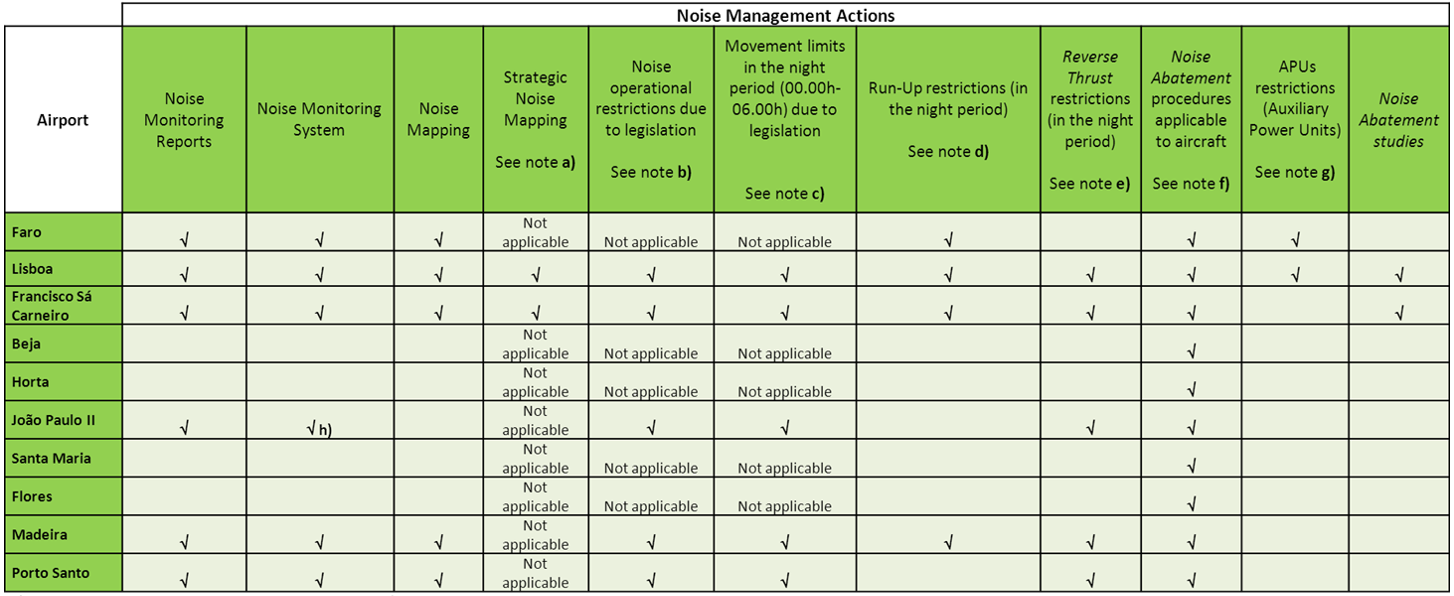
a) Arising from the provisions of Decree-Law No. 146/2006, of 31 July, with the amendments introduced by Decree-Law No. 136-A/2019, of 06 September
b); c)
In accordance with Order No. 303-A/2004, of 22 March, with its subsequent amendments, for Lisbon Airport
In accordance with Decree-Law No. 293/2003, of 19 November, for Lisbon Airport
In accordance with Order No. 831/2007, of 01 August, for Francisco Sá Carneiro Airport
In accordance with Regional Order No. 88/2010, of 09 September, for João Paulo II Airport
In accordance with Regional Order 69/ 2007, of 13 July, for Madeira Airport
In accordance with Regional Order 70/ 2007, of 13 July, for Porto Santo Airportd); e); f); g) As published in AIP- Portugal (Aeronautical Information Publication)
h) Through monitoring campaigns per IATA period
-
15. Can planes operate at night?
The airports that can operate at night, according to operational restrictions, are identified in specific legislation. There are operating restrictions in terms of the type of aircraft and maximum number of flights permitted for the period between midnight and 6 am for Humberto Delgado Airport - Lisbon, Francisco Sá Carneiro Airport - Porto, Madeira Airport, Porto Santo Airport and João Paulo II Airport – São Miguel, Azores.
-
16. How many flights can operate at night (midnight to 6 am) at Humberto Delgado Airport - Lisbon?
In the specific case of Lisbon, up to 91 flights are permitted per week. However, there may not be more than 26 flights per night. This scope does not include, for example, state, military, emergency or turboprop flights, given that these flights are of maximum necessity and/or minimum disturbance, according to the legislation in force.
And in Porto?
The maximum number of flights permitted during this period is 11 daily flights, 70 weekly and 2100 per year.
And in Madeira and Porto Santo?
In Madeira, the number of commercial flights per week may not exceed 80, with a maximum of 31 flights per day. Porto Santo cannot exceed 7 flights per week, with a maximum of 3 flights per day.
And at João Paulo II Airport in the Azores?
There may not be more than 30 flights per week, with a maximum of 6 flights per day.
-
17. Are there any exceptions to the night-time operating restrictions?
Yes. Bearing in mind specific and exceptional conditions, deemed to be force majeure, there are no restrictions on flights under the following general conditions:
a) aircraft carrying out humanitarian missions, for medical emergencies or evacuations;
b) aircraft in emergency situations, due to weather conditions, technical failure or flight safety;
c) flights which have required an unforeseen schedule change due to abnormal disruption in air traffic control;
d) flights up to 1 am scheduled for periods up to midnight, due to delays not the fault of the airport management body or the carrier;
e) flights to and from the Autonomous Regions of Madeira and the Azores, due to weather conditions;
f) landings made during the period between 5 am and 6 am, due to weather conditions, provided the arrival had been scheduled for after 6 am.
Adaptations of a local nature are defined in the applicable legislation, particularly for the airports in Madeira, Porto Santo and João Paulo II, São Miguel – Azores.
-
18. Why is Humberto Delgado Airport in Lisbon practically in the middle of the city?
Lisbon Airport was built in 1942, at a time when the entire area, including the surrounding land, was 100% rural. Lisbon City, as it was at the time, was far away from the airport. There are records that the discussions around its location in 1929 had supporters in favour of Portela, Sacavém and Campo Grande, on the city limits at the time. With the growth in population and urban expansion, new residential neighbourhoods came closer and closer to the airport, finally surrounding it completely.



